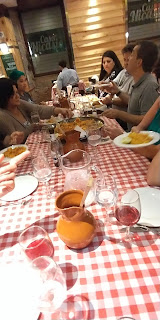Welcome to Madrid!
Friday, September 22.
Onward Ho… It is
early Friday when we grab a cab and lake our way to Sants Station in Barcelona
to catch our train to Madrid.
It is a sleek modern Ave train, a fast speed train that will
take us to Madrid in 3 hours.
We arrive at our hotel. Hotel Artrip, a small boutique hotel
in the Lavapies area of Madrid. It is new and modern with only 11 rooms. While
the rooms are small and lack a lot of space to store anything and not much
privacy. But we love it… the young staff are friendly and super accommodating.
The wifi is good and they provide a mobile hotspot we can take anywhere with us
and connect to the hotel’s internet… something we used daily for GPS as we
wandered the streets. They provided a great continental breakfast everyday and
were more than helpful with tips on where to go, how to get there, best
restaurants, shows, etc.
 |
| View from our Hotel Artrip in Madrid. |
Day one: we wander up a steep little street to the Plaza St.
Ana, a small square that is surrounded by little neighbourhood restaurants and
bars, a theatre (teatro), a flamenco place, and a beautiful old hotel. The
restaurants and bars spill into the square. We find a little table under an
umbrellas and sip ice cold white sangria (we decide we prefer the red.)Madrid
is very warm- high 20’s everyday- and the cold sangria is always very
refreshing.


We discover a lovely little Vinoteca (wine bar) with tapas
and decide we will return later that evening for dinner.
 Day Two: The day of walking tours.
Day Two: The day of walking tours.
The hotel has invited us to a free walking tour they provide
for guests. We meet our guide Laura at 10:00 and head out. Laura is a native
Madridian- she has spent her life in Madrid, as have her parents and her
grandparents. She is a wealth of knowledge and history.
We learn that Madrid is newer than some of the other cities
like Barcelona. It was just a small village until 1561 when King Phillip III
decided to move the capital from Toledo to Madrid and he established his court
there. The government of Spain was controlled largely through the Church which
was not always to the good of Spain. Even though Columbus had discovered the
Americas by then and was bringing ship loads of gold back to Spain, the money
was largely going to the Church to finance more cathedrals and convents and the
life of the aristocracy who were also supporting the Church. The infrastructure
of Spain was suffering and nothing was going to support industry or
agriculture. Phillip wanted to make government more independent.
The Royal Palace was built in Madrid and Phillip and his
court took up residence there. Today Madrid has over 3 million people and is a
bustling modern city. Madrid prides itself on its inclusiveness. There are no
separate quarters for this group of people or that group. Everyone mixes
together and live harmoniously.
We start our tour at our hotel in the area of Lavapies
(which means Washing feet – the area was once a mosque under Muslim rule and
this is the place where the worshippers washed their feet before going in to
prayer). We pass through a local market where fruits, vegetables, meat and
seafood are sold. We are told that Madrid, despite being a landlocked city, is
the 2nd highest consumer of seafood in Europe.
We stroll through the Literatos area which was created by
Napolean to bring a more French and cultured area to Madrid. Here writers and
artists lived and were free to thrive in their craft, creating some of the greatest
artists and writers like Cervantes and Picasso and Dali. Galleries and Museums
exist in this area.
We pass a cloistered convent. Under Spanish Catholic rule
the area had many convents, which were closed under French rule.
Streets are marked with ceramic signs that contain not only
the name of the street but a diagram depicting what it means since many people
in those times were illiterate.
We make our way to Plaza Mayor, the main (major) plaza of that
time. It is spectacular. There were several gates leading into a large central
courtyard that was the centre of the city. Everything took place here – from public
executions to markets and bull fights. The arches and walls are original but much
of the buildings were rebuilt after a massive fire in the 1800’s. Originally it was 7 stories high which was quite
a feat for those times. Everything above the ground floor is living
accommodations or apartments, now many are airbnb’s.
We continue through Puerta del Sol, the centre of Madrid.
And on to the Royal Palace and its beautiful gardens.
We bid good-bye to Laura and continue to explore on our own, making our way back along the walking street, Calle del Arenal.























































